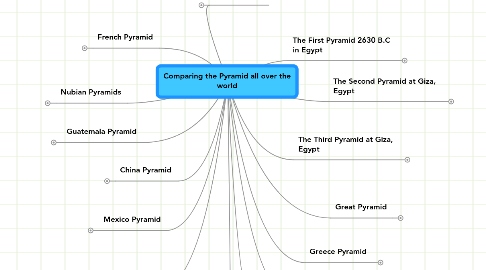Comparing the Pyramid all over the world
da Shanta 211


1. North America Pyramid
1.1. As with other continents, the mounds and pyramids of North America vary greatly. It could be that humankind has a primal need to build fake mountains, and that there are absolutely no connections between these sites. Or perhaps size and shape are irrelevant, and location is everything, and the guidelines for their placement were once universally known.
2. Peru Pyramid
2.1. Many of Peru’s ancient structures have lasted well, but not the pyramids. Most of them have eroded so much they are unrecognizable. Below is a restored adobe pyramid from around 800BC, located in the middle of the high-rise district of San Isidro.
3. Mexico Pyramid
3.1. Tres Zapotes, an Olmec site (1300-400 bc), was the first adobe-brick pyramid site in Mesoamerica. Pyramid, the largest is that of Chloula, in Mexico, which covers fifty acres of ground. The Largest in Egypt is that of Cheopsm near Cairo, which covers thirteen acres. Sir William Tite tells us it contains ninety million cubic feet ofstone, an could not be now built for less than thirty millions of money.
4. China Pyramid
4.1. There are many flat-topped pyramids in China. The First Emperor of Qin (circa 221 B.C.) was buried under a large pyramid outside modern day Xi'an. In the following centuries about a dozen more Han Dynasty royals were also buried under flat-topped pyramidal earth word.
5. Guatemala Pyramid
5.1. The huge pre-classic (150 bc-150 ad) Mayan site of El Mirador with its dozens of pyramids, including the Tigre Pyramid rising 18 stories high, probably the largest pyramid ever built by the Maya.
6. Nubian Pyramids
6.1. Nubian puramids were constructed at three sites in Nubian to serve as tombs for the kings and queens of Napata and Meroe. The Nubians built more pyramids than the Egyptians, but they are smaller. The Nubian pyramids were constructed at a steeper angle than Egyptian ones and were monuments to dead kings and queens. Pyramids were still being built in Nubian up to AD 300.
7. French Pyramid
7.1. The Louvre Pyramid is a large glass and metal pyramid, surrounded by three smaller ones, in the courtyard of the Musee du Louvre Museum in Paris, France. The large pyramd serves as the main entrance to the museum. Completed in 1989, it has become a landmark for the ity of Paris.
7.1.1. The glass pyramid of the Louvre is a true symbol of Paris. the attention-grabbing lighting concept, which Claude Engle and ERCO designed almost 20 years ago, has now been updated with cutting-edge technology: Metal Halide lamps. Architect: Ieoh Ming Pei, New York. Lighting designer: Claude Engle
8. India Pyramid
8.1. Detail of the main gopura (tower) of the Thanjavur Temple pyramid in Thanjavur, Tamil Nadu Many giant granite temple pyramids were made in South India during the Chola Empire, many of which are still in religious use today. Examples of such pyramid temples include Brihadisvara Temple at Thanjavur, the Temple of Gangaikondacholisvaram and the Airavatesvara Temple at Darasuram. However the largest temple pyramid in the area is Sri Rangam in Srirangam, Tamil Nadu. The Brihadisvara Temple was declared by UNESCO as a World Heritage Site in 1987.
9. The First Pyramid 2630 B.C in Egypt
9.1. The first pyramid was built as the burial place of King Djoser around 2630 B.C., by his gifted arcitect Imhotep. The first pyramid was built in the 27th century BC. All of the Egyptian pyramids between 2700 B.C-1800 B.C. The Egyptian pyramids developed in 2660 B.C. Nubian to the south of Egypt between 770 B.C. and A.D. 350.
10. The Second Pyramid at Giza, Egypt
10.1. The Bent Pyramid, located at the royal necropolis of Dahshur, approximately 40 kilometres south of Cairo, of Old kingdom Pharaoh Sneferu, is a unique example of early pyramid development in egypt. This was the second pyramid built by Sneferu.
10.1.1. The builder of the Bent Pyramid is thught to have been the Pharaoh Sneferu (2680-2565 BC), who was the first ruler of the 4th Dynasty. the Bent Pyramid is one of three (or maybe even four) pyramids built by the great Pharaoh Sneferu in Egypt's Old Kingdom.
10.1.1.1. More information
